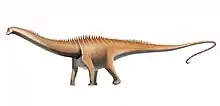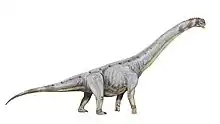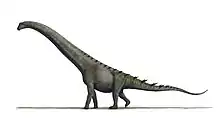Gongxianosaurus
Gongxianosaurus is a genus of basal sauropod dinosaur from the early Jurassic Period (Toarcian stage[1]). The only species is Gongxianosaurus shibeiensis. Based on four fragmentary to complete specimens found in China (Sichuan Province), it is one of the most completely known early sauropods. The skeleton is known in large part, missing both the hand and the majority of the skull.[2] Gongxianosaurus was firstly named and described in a short note published in 1998;[3] however, a comprehensive description has yet to be published.[4] Gongxianosaurus shibeiensis was named for the place it was found, near the village Shibei in Gong County (珙县; Pinyin: Gǒng Xiàn).[2]
| Gongxianosaurus | |
|---|---|
| Scientific classification | |
| Kingdom: | Animalia |
| Phylum: | Chordata |
| Clade: | Dinosauria |
| Clade: | Saurischia |
| Suborder: | †Sauropodomorpha |
| Clade: | †Sauropoda |
| Genus: | †Gongxianosaurus |
| Species: | †G. shibeiensis |
| Binomial name | |
| †Gongxianosaurus shibeiensis He et al., 1998 | |
Description
Gongxianosaurus may have reached 14 metres (46 ft) in length.[2] Like other sauropods, it moved quadrupedally (on four legs), as indicated by the elongated fore limbs that reached 70 to 75% of hind limb length.[2] The pedal phalanges were short and robust, as typical for sauropods. The pedal phalangeal formula, counting the number of phalanges for each digit starting from the innermost, was 2-3-4-5-1. All but the outermost digit ended in claws.[2] Unlike in other sauropods, pleurocoels (deep lateral excavations of the vertebrae) were absent;[2] thus, the vertebrae would have been quite massive. The sacrum was made of three fused sacral vertebrae, fewer than in later sauropods.[2][5] The chevrons were unbifurcated.[2]
An important characteristic of sauropod limbs is their reduced ossification – the tendency to replace bone by cartilage. Gongxianosaurus is the only known sauropod with ossified distal tarsals. Thus, either Gongxianosaurus was one of the basalmost sauropods, or ossified distal tarsals were present in other early sauropods but are simply not preserved due to the fragmentation of the specimens.[5]
Classification
|
Because the fossils are not fully described yet, available character information that can be used in cladistic analyses is limited. Thus, only few cladistical analyses have incorporated Gongxianosaurus. A recent analysis by Apaldetti et al. (2011) suggests that Gongxianosaurus was more basal than Vulcanodon, Tazoudasaurus and Isanosaurus, but more derived than the early sauropods Antetonitrus, Lessemsaurus, Blikanasaurus, Camelotia and Melanorosaurus.[6]
Discovery
Gongxianosaurus fossils were found near the village of Shibei (Sichuan province) in purple mudstones pertaining to the Ziliujing Formation (Dongyueshan Member).[3] These rocks are considered to be Toarcian in age (182.7 to 174.1 mya).[1] Thus, Gongxianosaurus is geologically younger than the "prosauropod" Lufengosaurus but older than the basal sauropod Shunosaurus.[3]
The fossils were found in May 1997 during a geological exploration. Excavation started in the same month and led to the recovery of a wealth of fossils in an area of approximately 200 square meters. While most fossils pertain to a new sauropod genus, remains of theropods have also been found.[3] The sauropod material includes four fragmentary to complete individuals similar in size, together encompassing most of the skeleton, though hand and skull bones were not found except a premaxilla and teeth. In 1998, the sauropod material was briefly described as a new genus and species, Gongxianosaurus shibeiensis, in a preliminary note by palaeontologists led by He Xinlu.[3] A more detailed description was announced, noting that excavation was still in progress while the paper was published.[3] In 2000, a second short description was published by Luo Yaonan and Wang Changsheng, also presenting Gongxianosaurus as a new sauropod and without mentioning the first description that was published two years before.[2][7] Also, much of the information published by Luo and Wang was already published by He and colleagues.[7]
Luo and Wang suggest that several bones may not pertain to the type species Gongxianosaurus shibeiensis but to a second species of Gongxianosaurus.[2]
References
- "Gongxianosaurus". The Paleobiology Database. Retrieved 24 December 2012.
- Yaonan, Luo; Wang Changsheng (2000). "A New Sauropod, Gongxianosaurus, from the Lower Jurassic of Sichuan, China". Acta Geologica Sinica - English Edition. 74 (2): 132–136. doi:10.1111/j.1755-6724.2000.tb00440.x. ISSN 1755-6724.
- He, Xinlu; Wang Changsheng; Liu Shangzhong; Zhou Fengyun; Liu Tuqiang; Cai Kaiji; Dai Bing (1998). "A new species of sauropod from the Early Jurassic of Gongxian Co., Sichuan". Acta Geologica Sichuan. 18 (1): 1–7.
- Upchurch, Paul; Paul Barrett; Peter Dodson (2004). "Sauropoda". In Weishampel; Dodson; Osmólska (eds.). The Dinosauria (2nd ed.). University of California Press. p. 298. ISBN 978-0-520-24209-8.
- Wilson, Jeffrey (2005). "Overview of Sauropod Phylogeny and Evolution". In Rogers; Wilson (eds.). The Sauropods: Evolution and Paleobiology. University of California Press. pp. 26–28. ISBN 978-0-520-24623-2.
- Apaldetti, Cecilia; Ricardo N. Martinez; Oscar A. Alcober; Diego Pol (9 November 2011). "A New Basal Sauropodomorph (Dinosauria: Saurischia) from Quebrada del Barro Formation (Marayes-El Carrizal Basin), Northwestern Argentina". PLoS ONE. 6 (11): 16. doi:10.1371/journal.pone.0026964. PMC 3212523. PMID 22096511.
- Glut, Donald F. (2003). "Gongxianosaurus". Dinosaurs: The Encyclopedia. 3rd Supplement. Jefferson, North Carolina: McFarland & Company, Inc. pp. 349–350. ISBN 978-0-7864-1166-5.












